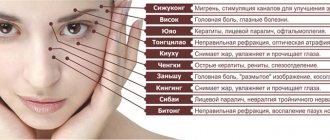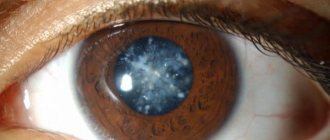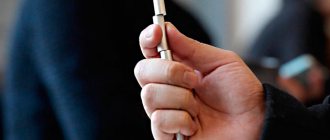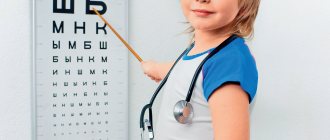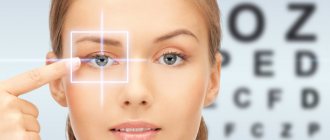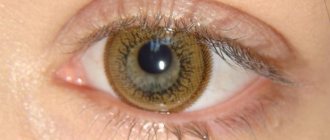A motorist who does not have diagnoses that limit the ability to see surrounding objects clearly enough will be able to obtain a vision certificate from an ophthalmologist for a driver’s license. During the medical examination, the motorist must obtain an examination by an ophthalmologist.
The specialist checks not only visual acuity, but also the correct perception of the color of objects and the angle of view. Citizens with 100% vision and those who are prescribed to wear glasses at all times will be granted permission without any restrictions.
Current visual impairments that are an obstacle to obtaining a driver's license
Blindness is on the list of diseases that prohibit driving any type of vehicle. Citizens with poor vision are worried whether they will be able to obtain permission from medical specialists to drive a car. The law allows the issuance of a driver's license to motorists whose pathological impairments do not exceed the permissible limits.
According to current legislation, persons who:
- receive a temporary residence permit for the first time;
- return the license after being deprived of it for drunk driving;
- replacement of rights after expiration.
Vision standards for drivers
According to the Russian Federation Regulation No. 1604 dated December 29, 2014 On the lists of medical contraindications, indications and restrictions for driving a vehicle, a strict distinction is established between professional drivers who operate passenger transport or special equipment and those who use the car for personal transportation purposes.
Drivers who receive licenses of categories A and B and operate a car for personal purposes must have a visual acuity of at least 0.8. If different acuity indicators are detected, it should be at least 0.6 in the other eye, and 0.2 in the other eye. Professional drivers, according to established standards, regardless of category, must have vision of more than 0.7, provided that both eyes have the same degree of visual acuity. In the case of different indicators on the eyes, one of them requires more than 0.8, and the second - 0.4.
OTHER VISUAL DISEASES
The Regulations on Military Medical Examination establish an exhaustive list of diseases for which people are not accepted into the army. The list of eye diseases that can be released from the army and enlisted in the reserves includes:
- various types of cattle;
- retinal detachment;
- glaucoma;
- complete blindness;
- dysfunction of the eye muscles and joint movement of the eyeballs;
- diseases, results of injuries and burns of the tear ducts, eyelids, orbits, conjunctiva;
- color vision impairment;
- congenital or acquired absence of the eyeball.
This is important to know: Who is subject to military registration of citizens in the Russian Federation and how it is carried out
What ophthalmological diseases will not allow you to get a license?
Citizens who have been diagnosed with:
- glaucoma (in later stages);
- retinal detachment;
- chronic and acute inflammation of the lacrimal sac;
- pathological changes in the optic nerve (death);
- double image of objects (diplopia);
- congenital and acquired pathologies of the eyelids, growths of the mucous membrane, creating an obstacle to normal vision.
In most cases, licenses can be issued after vision correction surgery has been performed. Rehabilitation processes and surgical intervention take 3 months or more. The medical commission will not give permission before this period. The patient comes to the examination with a correction device, if it was prescribed by a doctor.
It is not necessary to bring extracts from your medical history. To pass the examination, you need the final result of the treatment. The ophthalmologist will determine how much your vision has improved and decide whether to sign the permit.
WITH WHAT VISION WILL NOT BE TAKEN INTO THE ARMY IN 2021?
Young men with minor anatomical features of the eyelids and conjunctiva, farsightedness of 6-8 diopters, myopia of 3-6 diopters, and astigmatism of 2-4 diopters are recognized as fit for military service with fitness category B-3.
Conscripts with category B have chronic diseases of the cornea, iris, lens, retina and optic nerve in static development, glaucoma in the initial stage, diseases of the eye muscles and other pathologies. Persons with such diseases will serve in certain branches of the military, where special conditions for service are provided.
Deferment from the army for the eyes is obtained in the presence of diseases in the acute stages, postoperative conditions in which the ophthalmologist recognizes the conscript as temporarily unfit.
When can you drive?
- For drivers of motorcycles and cars, visual acuity should not be less than 0.8. But sometimes the eyes see differently. In this case, for the more sighted eye this figure is 0.6, and for the less sighted eye it is 0.2.
- Citizens who plan to make driving their main income must have visual acuity of at least 0.7. Or 0.8 for a healthy eye and at least 0.4 for a sick eye.
- If one eye is missing or does not see anything at all, the vision index must be at least 0.7. The figure is given without taking into account correction means.
- The refractive error of the eye should not exceed 3 diopters.
- Corrective agents should not change vision by more than 8 diopters.
What kind of vision does a driver need?
The vision of a car enthusiast and a professional driver must meet the prescribed standard. A motorist needs to distinguish colors well and clearly see surrounding objects. His reaction to events occurring while driving on the road depends on this.
It is irresponsible towards yourself and others to drive with visual impairments, in which the driver:
- does not at all distinguish figures and outlines of objects in the twilight;
- sees blurry during the day;
- has a limited angle of view.
Obtaining permission from an ophthalmologist for a license in categories A, B, C, D
An ophthalmologist's permission to drive various types of vehicles will be given to citizens who do not have vision pathologies that significantly reduce their quality of life. The category is determined according to the standard:
| Category | Leading eye | 2 eyes |
| A, B | Up to 0.6 | Up to 0.2 |
| C, D | Up to 0.8 | Up to 0.4 |
You can drive your own car with one seeing eye. When examined by a doctor, the remaining healthy visual organ should receive a score of at least 0.8 units.
The prescriptions are based on the presence of a dominant eye in most people. There are people whose both visual organs see the same. For them, obtaining rights is possible with an indicator of 0.7 units.
It is impossible to say unequivocally how well a person must see in order to obtain a license. Citizens receive ophthalmologist clearance without problems if they see all the lines of the verification table.
In other situations, the specialist takes into account the category for which the driver is applying. Driving passenger buses and trolleybuses with poor vision is not permitted.
What kind of vision do you need to have to get a driver's license?
The right to drive a vehicle is issued to those drivers whose vision indicators are within the normal range:
- for drivers of category “B” (restriction as - the driver can drive a car with a steering wheel) visual acuity must be at least 0.6 units in one eye and 0.2 units in the other;
- for drivers of category “C” - not less than 0.8 units in one eye and 0.4 units in the other.
- for drivers of category A, A1 or B2 with a motorcycle-type steering wheel - not lower than 0.6 on one and 0.2 on the other. Blindness in one eye is also allowed if visual acuity in the other is not lower than 0.8 units.
- If one eye is blind, the sharpness of the second should be at least 0.8 units.
- If a person does not have a dominant eye (both eyes see equally), then the acceptable value for driving vision may be 0.7 units in both the right and left eyes.
Accordingly, to the question: “With what vision are you not given a driver’s license?”, you can answer this way: “With acute vision, below the norm for certain categories (see above).
So, with what vision can you get a license? If you see the tenth line, then you will be given permission without any problems . But if there are any problems, visual acuity is reduced, then the doctor will take into account your driving category and build on that.
The power of lenses or glasses should not be more than 8 diopters. And the difference between the right and left glass (lens) should not exceed 3 diopters.
Colorblindness test
In addition to checking visual acuity, future drivers, as well as those who change their licenses, are checked to see if they have problems with color vision.
This is done in order to understand whether a person is confusing colors. After all, this is very important. What if he goes to red, confusing it with green?!
To determine color blindness, doctors use a special Rabkin table. They divide color sensitivity into 3 types:
- Trichromantics are people without pathology in terms of color perception.
- Protanopes are patients whose color perception in the red spectrum is impaired.
- Deuteranopes are those who have impaired color perception in the green spectrum.
People suffering from color blindness are not issued driver's licenses in our country.
The test for color perception goes like this: the patient is offered pictures with multi-colored circles.
He must concentrate on each of them and say which geometric figures or numbers are visible to him. If he doesn’t see the numbers or sees but not everything, then he has problems.
Checking your horizons
In addition to visual acuity and color perception, horizons are also checked . If the space viewed by the eye is less than 20 degrees, that is, narrow, then the person is prohibited from driving a car.
Narrowing of horizons is often observed with cataracts, retinal detachment, and glaucoma.
If you have had surgery to restore your vision, then you need to go through a medical examination again and get a license, but without the mark of driving with lenses/glasses.
Rules for passing vision tests
You should start testing only if you feel well. If you have any discomfort: the temperature has risen, headaches have appeared, you feel weak throughout the body, then it is better to refuse the procedure for now. You should not get checked after prolonged eye strain, or after taking certain medications.
In order to begin the examination, it is necessary to create certain conditions:
- the room where the subject is located should be very light;
- Under no circumstances should you tilt your head;
- when looking at the table, there is no need to squint your eyes;
- The monitor should be level.
Only by following all the rules can you get the most accurate results.
How to quickly improve your vision before a medical examination?
When a child goes to school, the load on his eyes increases sharply. Adults also sooner or later seek advice from a specialist.
The most common causes of visual impairment are:
- long work at the computer;
- bad habits (smoking and alcohol);
- reading text at very close range;
- painstaking work that requires eye strain;
- poor lighting;
- ultraviolet rays;
- body position when reading;
- diseases;
- lack of vitamins and microelements;
- tight clothes.
Reading while lying down and in shaking vehicles, lack of vitamins (especially vitamin A), and poor circulation when wearing tight clothes have a very detrimental effect on vision. Infectious eye diseases can also increase the risk of vision impairment, and in very rare cases they can even lead to blindness.
Lighting is of great importance. Very bright lighting harms the eye receptors, and therefore harms vision, but ultraviolet rays have the greatest negative effect.
How is it determined
Each of us has visited an ophthalmologist’s office at least once in our lives and remembers a table with letters of different sizes.
This is the so-called Sivtsev and Golovin table - a popular method for determining visual acuity in our country.
Letters of the alphabet (less often open rings) have a certain value, decreasing from line to line in arithmetic progression.
When compiling a table of visual acuity, the distance between the signs is also taken into account (at the bottom of the table it is smaller) and the degree of distinguishability (graphically similar signs such as “H” and “K” are deliberately written next to each other).
The subject perceives the table with each eye separately from a distance of 5 meters with the naked eye, and then with the selection of lenses, if necessary.
In the West, Snellen visual acuity tables are common, built on a similar principle, only the distance during the study is 6 meters, and there are ten lines.
Both tables are not perfect for a number of reasons (the distances between the lines are the same), therefore, for greater accuracy, Bailey-Lovey tables are used, where the sizes of the characters change exponentially.
This reduces eye strain and makes it possible to fairly accurately determine visual acuity, even if the patient sees only individual letters.
This method has an error, since the data is recorded from the words of the subject. Eye sensitivity may vary depending on the time of day, degree of lighting, fatigue, etc.
To reduce the error, when determining visual acuity, special devices are used: a refractometer (to determine the reaction of the pupil to light) and an ophthalmic mirror (a method of skiascopy, tracking the reflection of light in the pupil).
The use of several methods in combination allows you to accurately determine the degree of visual acuity.
What medications can improve the vision of young patients?
The choice of medications to improve a child’s vision needs to be approached even more responsibly. For young patients, ophthalmologists prescribe natural eye medicines that contain vitamins, as well as components of natural and herbal origin.
Recommendations for use
Some drugs have side effects. So you shouldn’t buy them yourself, as it is dangerous to your health.
In order for the purchased drug to bring maximum therapeutic effect, you must adhere to the following rules of use:
- Do not use drops without consulting a specialist.
- You should not use drops on an ongoing basis. As a rule, therapy lasts in courses of 1-3 months, and then rest is needed.
- Apply drops 1-5 times a day.
- 1-2 drops of the product should be sent to each conjunctival sac.
Microphthalmos is a developmental disorder of the eyeball that is difficult to correct. Treatment of styes on the eye with medications and folk remedies at home is described here. Anti-inflammatory eye drops Okulohel are described in this article.
Exercises to prevent and improve visual acuity
The exercises are quite simple, but effective. During the day, it is enough to allocate about 10 minutes to complete them. The most important thing is to do such warm-ups every day and regularly, and the results will be obvious. These exercises can also be done for myopia, farsightedness and myopia.
- Turn your eyes to the right with eye strain, then to the left, then look straight. We do this 15 times. It is very important that the muscles begin to work actively.
- We raise and lower our eyes up and down. Repeat 15 times.
- Slowly rotate your eyes clockwise, then counterclockwise. Repeat 6 times.
It must be remembered that vitamins and exercises are not enough to improve visual acuity at home. To get a decent result, you need to eliminate the negative impact on the eyes and take care of them.
When reading, you must keep the text at a distance of 30 to 35 centimeters from your eyes. To relieve eye strain when engaged in heavy mental work, it is recommended to switch to another activity for a few minutes every 2-3 hours.
Source: https://glazdoktor.ru/uluchshit-zrenie-pered-medkomi/
How is vision diagnosed by an ophthalmologist?
An examination by an ophthalmologist is mandatory; without the conclusion of this specialist, the medical examination cannot be considered completed. The easiest way is to contact specialized medical organizations that examine citizens before hiring and obtaining rights.
There are such establishments in every major city. Reception of citizens in specialized centers is carried out on a paid basis, but there are no queues; all specialists can be seen in one day. Residents of regional centers can go to their local clinic.
A check with an ophthalmologist is necessary for the driver himself. Timely identification of vision problems will help to avoid accidents on the road. A person who has poor vision will not be able to notice a pedestrian or an obstacle on the highway in time. A blind driver can kill himself and kill other people.
To assess the condition of the visual organs, the doctor uses modern diagnostic equipment or a standard table. A poster with rows of letters has been known to everyone since childhood; it is placed at a certain distance from the viewer. The patient reads the letters of each row, alternately covering one eye. The specialist makes a diagnosis based on the test results.
With diagnostic equipment, establishing visual acuity is much easier. The patient looks through the hole at the image inside the camera of the device, and the device at this time makes a diagnosis based on the pupil of the eye.
If the driver does not agree with the results of the medical examination, he can recheck his vision in any other clinic, preferably two. They come for re-examination with ready-made results.
Palming
What to do if you are constantly forced to work under conditions of prolonged visual strain and at the same time want to preserve your vision? The answer is simple - you need to master the eye palming technique. Palming is a term coined by Bates that refers to special eye exercises performed using the palms of the hands.
Bates's opinion is that all refractive errors arise due to tension and spasm of the eye muscles, and palming allows you to relax them and correct existing errors, as well as prevent the development of new anomalies.
The exercise itself is quite simple and does not require any additional skills or equipment. It can be performed anywhere (at home, at work, at school, in transport).
Re: How to deceive a doctor.
the vision testing system is outdated and I went to have my vision checked at the clinic using modern equipment, that’s all) the woman ophthalmologist at the military registration and enlistment office was friendly and kind, she wrote out a referral to the clinic without any problems
Posted by chel14
the vision testing system is outdated and I went to have my vision checked at the clinic using modern equipment, that’s all)
It might work, but it’s not very plausible. One of the options is to spend 2 nights constantly sitting at the computer, writing (an abstract, a report, earning money, etc.). The ophthalmologist at the military registration and enlistment office did not like that the eyes were red, so he sent me to the clinic for control. I slept well at night and my eyes cleared up, today everything is OK.
Is it possible to obtain admission from an ophthalmologist with poor vision?
Drivers who wear glasses or contact lenses must bring them with them to the medical examination. The doctor will take into account the results obtained without and with the ophthalmic device.
If it turns out that the previously prescribed glasses are no longer suitable, the specialist will recommend changing them to new ones.
When the patient does not see the required line of the checklist even with glasses, the doctor will refuse to sign the bypass sheet until a new check, for which the driver will have to appear in new optics.
Some motorists use a trick and come to their doctor's appointment wearing stronger glasses. This technique can play a cruel joke. The correction device causes discomfort, the eyes hurt and turn red. The ophthalmologist will definitely notice the discrepancy.
Visual acuity test
Visual acuity testing is mandatory. The examination is carried out taking into account corrections. All categories of driving have their own tolerances.
For people who wear glasses all the time, the difference between:
- lenses should be no more than 3 diopters:
- with two eyes without ophthalmological devices, up to 8 diopters are allowed between “–“ and “+”.
When should you contact an ophthalmologist:
- when vision deteriorates, in particular if one of the two eyes begins to see worse;
- when a veil appears before the eyes, double vision;
- for pain in the eyes;
- with regular dry eyes;
- with frequent and severe redness of the eyes;
- when you feel “sand” or a foreign body;
- when floating “flies” appear before the eyes;
- with discharge from the eyes, lacrimation;
- when rainbow circles appear before the eyes;
- with rapid eye fatigue;
- with photophobia;
- if it is impossible to find glasses;
- if you feel discomfort while wearing glasses;
- for headaches while wearing glasses;
- for eye injuries.
At the Excimer ophthalmology clinic, each patient’s visit to an ophthalmologist begins with a full diagnostic examination of the visual system. During diagnosis, studies are carried out that, in addition to visual acuity, make it possible to determine the functional and anatomical features of the visual apparatus. Such a detailed vision diagnosis gives the ophthalmologist the opportunity to determine the cause of poor vision, identify potential threats and, if treatment is required, select the most preferable option in each specific case. To undergo diagnostics, you will only need one visit to the clinic, during which a complete picture of the patient’s vision condition will be compiled and, if necessary, individual treatment will be selected and its effectiveness will be monitored.
"A ray of light"
Deterioration of vision occurs due to overwork of the eye muscles, which begin to cope poorly with their functions. However, science has proven that the light of the sun helps us strengthen muscle tissue, which promotes the production of special enzymes.
To strengthen the muscles of the visual apparatus, you need to sit under the rays of the bright sun, turn your face towards the light and close your eyes. You must remain in this position for 10 minutes.
In winter and on cloudy days, an electric lamp can replace the sun. With her, such an exercise will need to be performed 5 to 6 times a day for only one minute.
Colorblindness test
Deviations in color perception are a congenital disease. A person who has such deviations may not be aware of their presence. Usually colorblind people do not distinguish between green and red colors.
The danger of the disease is that the driver does not understand which traffic light is on and may start driving through a red light, perceiving it in the green spectrum.
To determine color sensitivity, ophthalmologists use the Rabkin table. All people are divided into three types based on the ability to perceive colors and shades:
- Trichromantics are a large group that includes people who do not have pathology. The number of perceived shades of faces with normal color perception differs from innate abilities. Artistically gifted people see several dozen times more different gradations of tones than ordinary people.
- Protanopes are patients who do not perceive the colors and tones of the red spectrum.
- Deuteranopes do not recognize the color green.
Examination by an ophthalmologist
When passing a medical examination to obtain a driver's license, a mandatory item in the medical certificate is an ophthalmologist's opinion. First of all, safety on the road depends on the state of vision of the driver of a vehicle, so doctors pay special attention to vision when examining future candidates for driving.
If you are not sure what kind of certificate is needed to obtain or replace a license, contact our lawyers.
Visual acuity
An eye examination begins with an indicator - visual acuity: determined by the ability of the eyes to perceive separately two points that are at a certain distance from each other. The doctor suggests that the driving candidate look at a special board with letter lines of various sizes at a distance of five meters. Vision analysis is carried out on both eyes in turn.
Vision is considered ideal if you were able to read the tenth line from the bottom without any problems. If unsuccessful, you are asked to read other lines written in larger font (ninth, eighth, etc.).
If visual acuity is impaired, the driver has the right to drive a car wearing contact lenses or glasses. If the future driver already has correction devices, then in this case visual acuity is checked using them.
Training for a driver's license is allowed if vision indicators meet the following standards:
- Category “B”: if one eye sees worse than the other, visual acuity must be at least 0.6 units for one and 0.2 units for the other.
- Category “C”: if one eye sees worse than the other, visual acuity is at least 0.8 units for one eye and 0.4 units for the other. It is also allowed when both eyes have a visual acuity of 0.7 units.
- Using correction devices: optical power should not exceed plus or minus eight diopters, and the difference between glasses and lenses in both eyes is three diopters.
- If there is complete blindness in one eye or the absence of one of the organs of vision, in the second the acuity must exceed 0.8 units.
Color perception
A mandatory indicator when testing vision is color perception: the perception of light emission. During the medical examination to obtain a driver's license, the driver's ability to distinguish the colors of a traffic light is determined. To test for color perception, the Rabkin table is used.
Ophthalmologists define three types of people according to the degree of color perception:
- Trichromancers (normal).
- Protoanopes (impaired color perception in the red spectrum).
- Deuteranopes (impaired color perception in the green spectrum).
If this indicator deviates from the norm, then it cannot be corrected with lenses or glasses.
Horizon
One of the obstacles that driver's license applicants face during eye exams is tunnel vision. Horizons are determined by examining the extreme narrowing of vision, which should not be more than twenty degrees.
Narrow vision also cannot be corrected with the help of corrective devices, and in this situation the person should not be allowed to take driving lessons.
Eye diseases
There are other types of eye diseases that can serve as an obstacle to obtaining a driving license, depending on their severity: retinal detachment, glaucoma, cataracts. Only a doctor can give a final conclusion about the state of eye health after conducting the necessary examination.
The ophthalmologist examines the candidate driver in several directions at once, studying such points as:
- Visual acuity;
- Level of color perception;
- Fields of view.
During the examination, a person may show some deviations from the norm, but such deviations are not always a categorical prohibition for driving a car.
In order to correctly understand what criteria exist for each stage of an ophthalmological examination, it is worth considering them in detail.
It must be said right away that those drivers who use glasses/lenses in everyday life should definitely take them to an appointment with an ophthalmologist (you will need to wear them for the examination).
Visual acuity is diagnosed, as a rule, using a standard table (with letters). The following are considered a positive result (taking into account all means of vision correction):
- Category “B” is more than 0.6 for both eyes or the “best” one, as well as more than 0.2 for the visually impaired eye;
- Category “C” - more than 0.7 for both eyes or more than 0.4 for the visually impaired eye and 0.8 or more for the “better” eye;
- Drivers of passenger and special vehicles (cat. “B”) – at least 0.4 in the weak eye and 0.8 in the “better” eye.
Separately, it should be noted that if a person wears glasses/lenses all the time, then the optical power should not exceed “ ” or “-” 8 diopters, and the difference between the power of the right and left lenses should not be more than 3 diopters.
In the case when one eye of a person does not see at all or is completely absent, then he can drive a car only if the second eye has an acuity of more than 0.8 without any correction and there are no visual field impairments.
Color vision disorder
The study of this indicator is carried out using the Rabkin table.
If previously such a deviation from the norm as color blindness was not an important indication for refusal to issue a license, now the level of color perception of a driver candidate may well have a significant impact on the final decision of the medical board.
The ophthalmological conclusion largely depends on the degree of color vision impairment, but sometimes even with serious deviations from the norm, the doctor can make a positive decision, but with an appropriate note in the certificate and license.
Width of field of view (horizon)
According to existing standards, a narrowing of the field of view of 20° is considered the maximum permissible.
This disorder is rare and, like color blindness, cannot be corrected with lenses or glasses. A narrowing of a person’s visual fields, as a rule, is a symptom of more serious diseases, which in themselves are contraindications for driving a vehicle.
Fundus examination procedure
Dilatation of the eye pupil can be achieved using special eye drops. When they get on the surface of the eye, they penetrate the tissue and do not allow signals to pass through to the muscle that constricts the pupil. Essentially, drops to dilate the pupils affect the receptors and they stop receiving the signal passing along the oculomotor nerve.
Special medications are dropped before the eye examination. Then the patient is asked to wait 20 to 30 minutes, this is necessary so that the medicine has time to act and dilate the pupil of the eye as much as possible. In some cases, the medicine is dripped three times in a row with a break of several minutes. During instillation before checking the eyes and vision, a burning sensation may occur, but the sensation passes fairly quickly.
Previously, Atropine was instilled into the eyes; currently, tropicamide is mainly used - a safe medicine with rare side effects. Atropine is recommended for use if there is a suspicion of a spasm of accommodation (false myopia). Such procedures, which essentially improve vision, help to correctly determine whether the patient needs glasses and how strong.
How to cure myopia at home
Treating myopia in the comfort of your home is a very attractive idea. Everyone wants to improve their eye condition without leaving their apartment. We hasten to please you: with the right approach to prevention and conservative treatment, you can correct minor myopia at home. Such measures are especially effective in preventing the development of refractive errors, as well as in the fight against incipient myopia and false myopia. But to do this, you need to know exactly how to restore vision using simple and affordable means.
Among them:
- healthy lifestyle,
- proper nutrition,
- gymnastics and eye massage,
- prevention,
- folk recipes.
Right way of life
The answer to the question of how to treat myopia will depend on the age of the patients, since for adults the tactics are the same, but if the vision of a teenager is restored, it is completely different. However, the rules for a healthy lifestyle in general will be common for everyone:
- Workplace lighting: the ideal option is natural light, so it is better to place your desk near a window. The table lamp must be equipped with a lamp with a brightness of 60 W. It is better to give preference to fluorescent lamps.
- Reading: you need to get used to holding a book at a distance of at least 30 cm from your eyes. It is forbidden to read in dim light, in a lying position (especially on your side), or in moving vehicles. The font should be large and clear enough so as not to strain your eyes.
- Screens: Any monitor is harmful to the eyes because it involves focusing at one distance for a long time. Breaks from work will save you from spasms of overstrained eye muscles: from 5 to 15 minutes every hour. Do them with your eyes closed or do the exercises.
- Mobility: sufficient physical activity, a change of activity, walks in the fresh air, and playing sports (without impact loads) are very important.
Nutrition
With the help of a balanced diet, you can both improve your vision at home and prevent its deterioration. To do this, you need to follow a regimen, eat every day at the same time in at least three meals a day. A healthy eye diet should include:
- Fresh vegetables: carrots, cabbage, beets, tomatoes.
- Fruits and berries: blueberries, peaches, citrus fruits.
- Protein: eggs, dairy and fermented milk products, lean meat, sea fish and seafood.
Eye exercises
Among the large amount of information on how to get rid of myopia at home, special attention is always paid to everyday physical activity and eye exercises. By learning a number of basic exercises and finding a few minutes in your daily schedule to perform them, you will achieve impressive results in preventing spasms of the eye muscles and reducing myopia
The video below presents an interesting set of eye exercises at home, which has received excellent reviews.
It focuses not only on the eyes, but also on working with the whole body.
Eye massage
By performing a special eye massage at home, you can achieve sustainable vision correction for certain types of myopia. The massage concerns not only the eyes, but affects the entire face, improving blood circulation. Learn techniques for self-massage that is beneficial for your eyesight at home by watching the following video:
Checking your horizons
Visual impairment is most often a secondary manifestation of diseases such as:
- glaucoma;
- retinal detachment;
- cataract.
Narrowing your horizons below 20 degrees leads to a ban on driving a vehicle.
Improvement in vision may occur after surgery. After the treatment, at least 3 months must pass before the medical commission gives permission to obtain a driver’s license. If the attending physician has prescribed constant wearing of glasses, they come to the examination with an ophthalmological device.
How to improve vision at home?
There are quite a few reasons that negatively affect the condition of the visual apparatus. These include working at a computer, lack of sleep, spinal diseases, chronic fatigue, poor nutrition, insufficient physical activity, and so on.
To prevent vision diseases and improve it, you should follow these recommendations:
- Do eye exercises every day. It helps improve blood circulation in this area and train muscle fibers.
- You need to do neck stretching exercises every day. This increases blood circulation in the brain area.
- It is important to quit smoking. Tobacco leads to vasoconstriction.
In addition to the above, you need to eat right, include healthy vitamins and minerals in your diet, and eat more vegetables and fruits.
Solarization
Previously, it was believed that it was necessary to perform all exercises for solarization under the influence of bright sunlight. At the moment, this opinion has changed, as it was found that a large amount of ultraviolet radiation negatively affects the retina of the eyes. Burns may also occur.
To date, procedures have been developed with minimal exposure to ultraviolet radiation on the eyes. These techniques are performed in the morning at dawn and in the evening at sunset:
- A person stands under the shadow, so that one part of his body is in the dark and the other in the light. They alternately swing their head and body, while both eyes should be placed first in the sun, then in the shade. During the exercise, your eyes should be closed.
- They also stand on a platform where one half of the body is in the shade and the other in the sun. A person needs to rise on his toes, lower his head, and open his eyes slightly. The body is turned left and right, the eyes should be either in the shade or in the sun.
- During dawn and dusk, they fix their gaze directly on the sun. First you need to consider it for 1 minute, then gradually increase the time, bringing it to 10 minutes. At the same time, the eyes should not experience overstrain; if it occurs, the time is limited.
To use exercises, a person should not have contraindications to them. Therefore, you should first consult with an ophthalmologist. All actions are performed daily. If a person experiences increased strain on the eyeballs, for example, when using a computer every day, the exercise is repeated several times a day during eye fatigue.
Is it possible to get a license with poor eyesight?
It is difficult to deceive an experienced doctor. Some motorists download an ophthalmological table on the Internet and then memorize it. This option works if the office is not equipped with a diagnostic device. Now this equipment is available almost everywhere, even in optics.
In addition to the letter table, specialists have graphic posters in their offices. To confirm the diagnosis, the ophthalmologist may ask the patient to answer questions related to the pictures shown on the test stand.
In practice, doctor deception often causes an accident. The road does not forgive mistakes. In an accident, the culprit himself and strangers may suffer.
What does the GCL mark on your license mean?
The GCL mark makes it clear to the inspector that the motorist has the right to drive only with vision-correcting devices (glasses, lenses). Such a citizen is prohibited from driving without ophthalmic devices.
Special marks are located on the back of the driver's document. In addition, the license may contain the entry “glasses are required” or “lenses are required. The clarified wording obliges the wearing of a certain type of correction devices while driving.
For motorists who alternately use glasses or lenses, the phrase “glasses or lenses are required” is included in the license.


